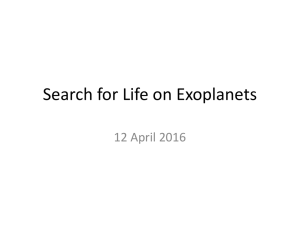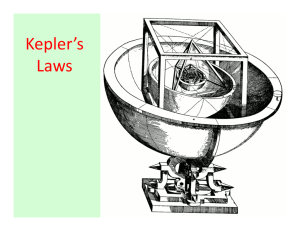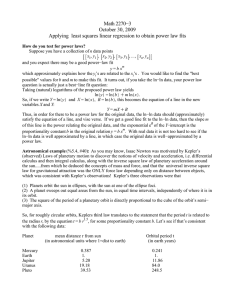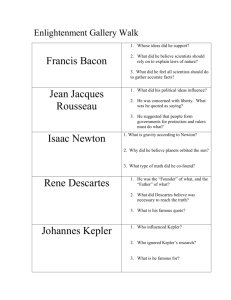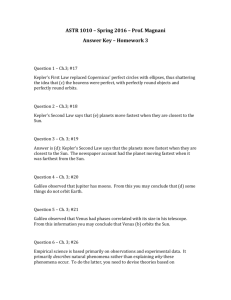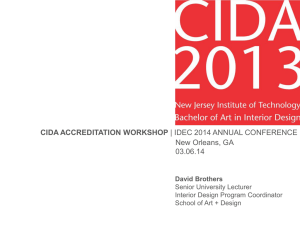Kepler’s laws and a heliocentric universe Triumph of science over tradition
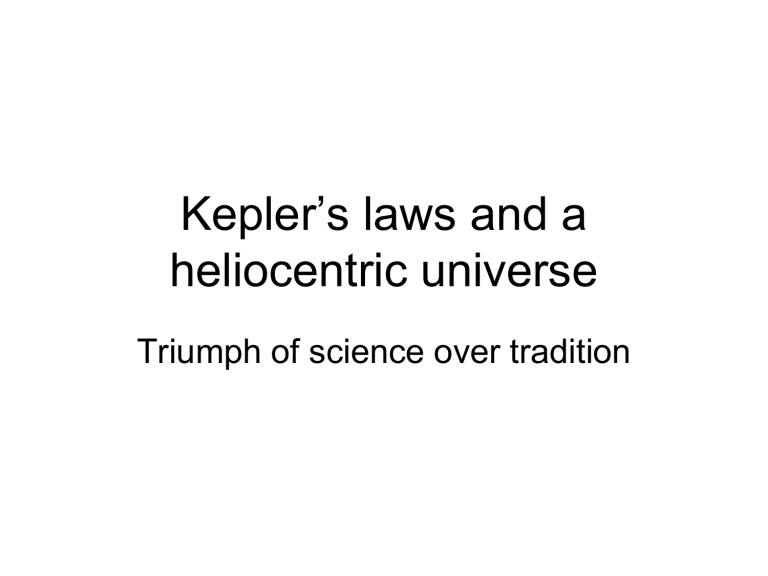
Kepler’s laws and a heliocentric universe
Triumph of science over tradition
Goals & Outcomes
• Appreciating science in general, and astronomy in specific.
• Understanding how knowledge is gained and be critical of what you see and hear. You will begin to ask “How can we test that?” when forming hypotheses or “How do we know that?” when reading new information.
• Developing a working knowledge of the scientific method and how to apply it to real world situations.
• Critically analyzing and evaluating information, scientific or otherwise
• Learn some simple astronomical nomenclature/terminology.
• Understand how orbits are related to gravity
• Understand and be able to make predictions about orbital motions, as explained by Kepler’s laws as revised later by Isaac
Newton.
Big questions
• What are Kepler’s 3 laws?
• What do they deal with?
• Give examples.
________ laws of planetary motion
• Johannes _____________ (page 72): 1571 - 1630
• Used planet data taken by _____________ (page 71)
• Kepler realized the _______________ could be very accurately _____________________________.
• Earlier models involved only ____________________.
• ___________________________________________
__________________________________________.
• Kepler never knew WHY his laws were right or what caused them – he only found rules that described the data.
• ____________ (1642 – 1727) figured out why Kepler’s laws worked. He also revised Kepler’s laws slightly.
Kepler’s 1
st
law
• See Page 73 and figure 3.19 on page 74.
• Kepler’s version: Orbits of _________________
______ are ______ with the _______________
_________________.
• Newton: works on _________ orbiting ____________.
– A note for the students to ponder:
How would orbit(s) work in an equal-mass binary star system?
Ellipses
• Ellipses are “___________________.”
• To see an ellipse: instead of looking at a plate from above, tilt the plate.
• ____ are a special _______________.
• ______________________________
______________________________
• Closest to Sun= _________________.
Furthest = ______________.
• Give another example of an elliptical orbit
• (page 42)
Kepler’s 2
nd
Law
• Pages ____. Slightly ____________
• _____________________________ and sweeps out
“equal areas in equal times.”
• ______________________? Let’s discuss figure 3.20.
• See also animations at: http://www.sunsite.ubc.ca/LivingMathematics/V001N01/UBCExamples/Kepler/kepler.html
AND http://physics.syr.edu/courses/java/mc_html/kepler_frame.html
• Check the webpage to see these links.
• Simple translation:
• ___________________________________________
__________________________________________.
• Lecture Tutorial, pages 21-24
Preview of tutorial questions
• Who moves faster? A or B? A or C?
A 1 sec
B 1 sec
C 0.5 sec
Lecture Tutorial, pages 21-24.
• NOTE: First picture is different compared to 2 nd & 3 rd
A consequence of Kepler’s 2
nd
law
• Planets orbit fastest when ______
• When is it slowest?
• When is it speeding up?
• When is it slowing down?
• Talk to your neighbor for a minute. I will
NOT tell you the answer today, except for the blank above.
Kepler’s 3
rd
law
• Pages 73-74.
• English: ____________________________________
_____________obeying a mathematical relationship:
• Math (p. 74):
• ________________________________________________
• The “______________________________,
__________________. The number depends on ____
________________ of the system.
– ________________________________________________
________________________________________
• This (some number) is how we determine _________
__________________________________________.
– What would you need to measure to calculate __________?
Student activities
• Lecture Tutorial, pages 25-27
• Ranking Tasks are also good practice
End of geocentrism
• Prior to Kepler, common belief was:
_________________________________
• Nicholas __________ (1473 – 1543) gave the ______________________________.
• _________ interpretation of ___________ showed __________________________
Galileo Galilei (1564-1642)
• __________ nailed the coffin shut on geocentrism.
1. ________________. He saw _______ come and go.
2. _______________________. He saw ___________
_____________ . See posters. “_______________.”
3. _____________________, like _________ . Can’t be explained if Venus and Sun orbit Earth.
(He also knew of a supernova seen by Tycho Brahe
(1546-1601)! And he knew of newly discovered comets.)
Still, Church didn’t like it. Galileo put in house arrest!
But Church __________________
_______________.
